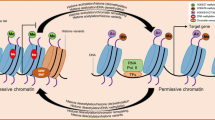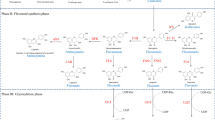Abstract
Histone acetylation plays a critical role in controlling chromatin structure, and reactive oxygen species (ROS) are involved in cell cycle progression. To study the relationship between histone acetylation and cell cycle progression in plants, sodium butyrate (NaB), a histone deacetylase (HDAC) inhibitor that can cause a significant increase in histone acetylation in both mammal and plant genomes, was applied to treat maize seedlings. The results showed that NaB had significant inhibition effects on different root zones at the tissue level and caused cell cycle arrest at preprophase in the root meristem zones. This effect was accompanied by a dramatic increase in the total level of acetylated lysine 9 on histone H3 (H3K9ac) and acetylated lysine 5 on histone H4 (H4K5ac). The exposure of maize roots in NaB led to a continuous rise of intracellular ROS concentration, accompanied by a higher electrolyte leakage ratio and malondialdehyde (MDA) relative value. The NaB-treated group displayed negative results in both TdT-mediated dUTP nick end labelling (TUNEL) and γ-H2AX immunostaining assays. The expression of topoisomerase genes was reduced after treatment with NaB. These results suggested that NaB increased the levels of H3K9ac and H4K5ac and could cause preprophase arrest accompanied with ROS formation leading to the inhibition of DNA topoisomerase.









Similar content being viewed by others
Abbreviations
- NaB:
-
Sodium butyrate
- BSA:
-
Albumin from bovine serum
- PBS:
-
Phosphate-buffered saline
- ROS:
-
Reactive oxygen species
- MDA:
-
Malondialdehyde
- TUNEL:
-
TdT-mediated dUTP nick end labelling
- H3K9ac:
-
Acetylated lysine 9 on histone H3
- H4K5ac:
-
Acetylated lysine 5 on histone H4
References
Bae YS, Kang SW, Seo MS, Baines IC, Tekle E, Chock PB, Rhee SG (1997) Epidermal growth factor (EGF)-induced generation of hydrogen peroxide role in EGF receptor-mediated tyrosine phosphorylation. J Biol Chem 272:217–221
Bandyopadhyay D, Mishra A, Medrano EE (2004) Overexpression of histone deacetylase 1 confers resistance to sodium butyrate-mediated apoptosis in melanoma cells through a p53-mediated pathway. Cancer Res 64:7706–7710
Bartek J, Lukas J (2001) Mammalian G1-and S-phase checkpoints in response to DNA damage. Curr Opin Cell Biol 13:738–747
Beers RF, Sizer IW (1952) A spectrophotometric method for measuring the breakdown of hydrogen peroxide by catalase. J Biol Chem 195:133–140
Benková E, Hejátko J (2009) Hormone interactions at the root apical meristem. Plant Mol Biol 69:383–396
Castano IB, Brzoska PM, Sadoff BU, Chen H, Christman MF (1996) Mitotic chromosome condensation in the rDNA requires TRF4 and DNA topoisomerase I in Saccharomyces cerevisiae. Genes Dev 10:2564–2576
Chua YL, Watson LA, Gray JC (2003) The transcriptional enhancer of the pea plastocyanin gene associates with the nuclear matrix and regulates gene expression through histone acetylation. Plant Cell On 15:1468–1479
Chung PJ, Kim YS, Jeong JS, Park SH, Nahm BH, Kim JK (2009) The histone deacetylase OsHDAC1 epigenetically regulates the OsNAC6 gene that controls seedling root growth in rice. Plant J 59:764–776
Clayton AL, Hazzalin CA, Mahadevan LC (2006) Enhanced histone acetylation and transcription: a dynamic perspective. Mol Cell 23:289–296
Darzynkiewicz Z, Traganos F, Xue S-B, Melamed MR (1981) Effect of n-butyrate on cell cycle progression and in situ chromatin structure of L1210 cells. Exp Cell Res 136:279–293
de Kok TM, Driece HA, Hogervorst JG, Briedé JJ (2006) Toxicological assessment of ambient and traffic-related particulate matter: a review of recent studies. Mutat Res/Rev Mutat Res 613:103–122
Dickey JS, Redon CE, Nakamura AJ, Baird BJ, Sedelnikova OA, Bonner WM (2009) H2AX: functional roles and potential applications. Chromosoma 118:683–692
Draper H, Squires E, Mahmoodi H, Wu J, Agarwal S, Hadley M (1993) A comparative evaluation of thiobarbituric acid methods for the determination of malondialdehyde in biological materials. Free Rad Biol Med 15:353–363
Fischle W, Wang Y, Allis CD (2003) Histone and chromatin cross-talk. Curr Opin Cell Biol 15:172–183
Fuchs J, Demidov D, Houben A, Schubert I (2006) Chromosomal histone modification patterns—from conservation to diversity. Trends Plant Sci 11:199–208
Gajewska E, Skłodowska M (2007) Effect of nickel on ROS content and antioxidative enzyme activities in wheat leaves. Biometals 20:27–36
Green R, Fluhr R (1995) UV-B-Induced PR-1 accumulation is mediated by active oxygen species. Plant Cell 7:203–212
Hartwell LH, Weinert TA (1989) Checkpoints: controls that ensure the order of cell cycle events. Science 246:629–634
Hu Y et al. (2011) Trichostatin A selectively suppresses the cold-induced transcription of the ZmDREB1 gene in maize PloS one 6:e22132
Hug BA, Lazar MA (2004) ETO interacting proteins. Oncogene 23:4270–4274
Kim J-M et al (2008) Alterations of lysine modifications on the histone H3 N-tail under drought stress conditions in Arabidopsis thaliana. Plant Cell Physiol 49:1580–1588
Kuefer R et al (2004) Sodium butyrate and tributyrin induce in vivo growth inhibition and apoptosis in human prostate cancer. Br J Cancer 90:535–541
Lallemand F, Courilleau D, Buquet-Fagot C, Atfi A, Montagne M-N, Mester J (1999) Sodium butyrate induces G2 arrest in the human breast cancer cells MDA-MB-231 and renders them competent for DNA rereplication. Exp Cell Res 247:432–440
Li L, Yang J, Tong Q, Zhao L, Song Y (2005) A novel approach to prepare extended DNA fibers in plants. Cytometry A 63:114–117
Lichtenthaler HK, Burgstahler R, Buschmann C et al. (1983) Effect of high light and high light stress on composition, function and structure of the photosynthetic apparatus[M]//Effects of stress on Photosynthesis. Springer Netherlands, pp 353–370
Löffler H, Lukas J, Bartek J, Krämer A (2006) Structure meets function—centrosomes, genome maintenance and the DNA damage response. Exp Cell Res 312:2633–2640
Longhin E, Holme JA, Gutzkow KB, Arlt VM, Kucab JE, Camatini M, Gualtieri M (2013) Cell cycle alterations induced by urban PM2. 5 in bronchial epithelial cells: characterization of the process and possible mechanisms involved. Part Fibre Toxicol 10:63
Lu H-R et al (2005) Reactive oxygen species elicit apoptosis by concurrently disrupting topoisomerase II and DNA-dependent protein kinase. Mol Pharmacol 68:983–994
Malumbres M, Barbacid M (2009) Cell cycle, CDKs and cancer: a changing paradigm. Nat Rev Cancer 9:153–166
Marks PA, Richon VM, Rifkind RA (2000) Histone deacetylase inhibitors: inducers of differentiation or apoptosis of transformed cells. J Natl Cancer Inst 92:1210–1216
Nigg EA (1995) Cyclin-dependent protein kinases: key regulators of the eukaryotic cell cycle. Bioessays 17:471–480
O’Sullivan RJ, Kubicek S, Schreiber SL, Karlseder J (2010) Reduced histone biosynthesis and chromatin changes arising from a damage signal at telomeres. Nat Struct Mol Biol 17:1218–1225
Rao R et al (2008) HDAC6 inhibition enhances 17-AAG-mediated abrogation of hsp90 chaperone function in human leukemia cells. Blood 112:1886–1893
Schumb WC, Satterfield CN, Wentworth RL (1955) Hydrogen peroxide, american chemical society monograph series. Reinhold Pub. Co.: New York
Shapiguzov A, Vainonen JP, Wrzaczek M, Kangasjärvi J (2012) ROS-talk—how the apoplast, the chloroplast, and the nucleus get the message through. Front Plant Sci 3:292
Strahl BD, Allis CD (2000) The language of covalent histone modifications. Nature 403:41–45
Sundaresan M, Yu Z-X, Ferrans VJ, Irani K, Finkel T (1995) Requirement for generation of H2O2 for platelet-derived growth factor signal transduction. Science 270:296–299
Vos SM, Tretter EM, Schmidt BH, Berger JM (2011) All tangled up: how cells direct, manage and exploit topoisomerase function. Nat Rev Mol Cell Biol 12:827–841
Wang P, Zhao L, Hou H, Zhang H, Huang Y, Wang Y, Li H, Gao F, Yan S, Li L (2015) Epigenetic changes are associated with programmed cell death induced by heat stress in seedling leaves of Zea mays. Plant Cell Physiol. doi:10.1093/pcp/pcv023
West G, Inzé D, Beemster GT (2004) Cell cycle modulation in the response of the primary root of Arabidopsis to salt stress. Plant Physiol 135:1050–1058
Yan S et al (2013) Comparison of chromatin epigenetic modification patterns among root meristem, elongation and maturation zones in maize (Zea mays L.). Cytogenet Genome Res 143:179–188
Zhang L et al (2011) ABA treatment of germinating maize seeds induces VP1 gene expression and selective promoter‐associated histone acetylation. Physiol Plant 143:287–296
Zheng XX, Zhou T, Wang XA, Tong XH, Ding JW (2015) Histone deacetylases and atherosclerosis. Atherosclerosis 240:355–366
Acknowledgments
This work was supported by the NSFC (No. 31571265 and 31401706 ).
Author information
Authors and Affiliations
Corresponding author
Ethics declarations
Conflict of interest
The authors declare that they have no conflict of interest.
Additional information
Handling Editor: Pavla Binarova
Rights and permissions
About this article
Cite this article
Zhang, Q., Wang, P., Hou, H. et al. Histone acetylation and reactive oxygen species are involved in the preprophase arrest induced by sodium butyrate in maize roots. Protoplasma 254, 167–179 (2017). https://doi.org/10.1007/s00709-015-0928-9
Received:
Accepted:
Published:
Issue Date:
DOI: https://doi.org/10.1007/s00709-015-0928-9




